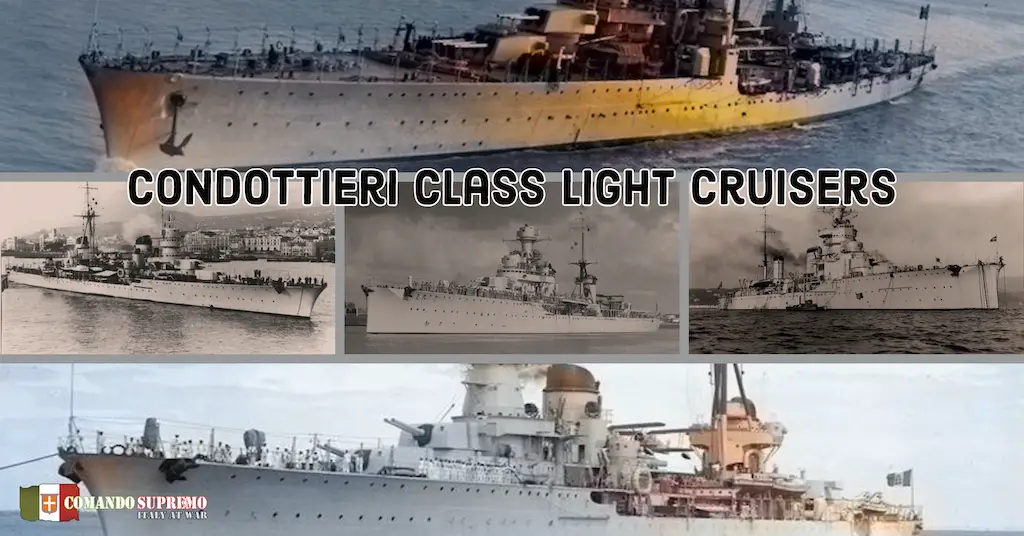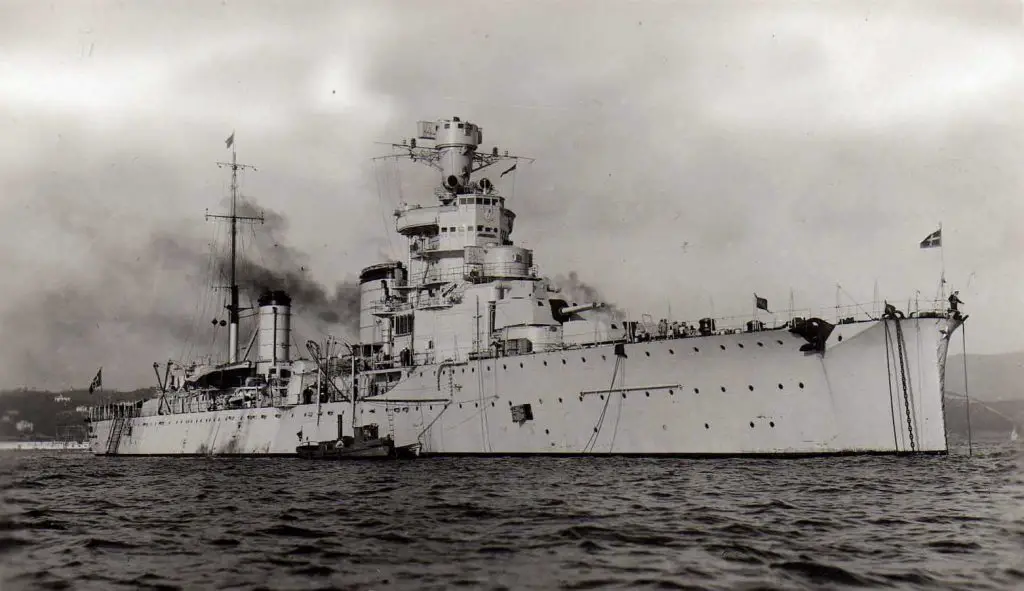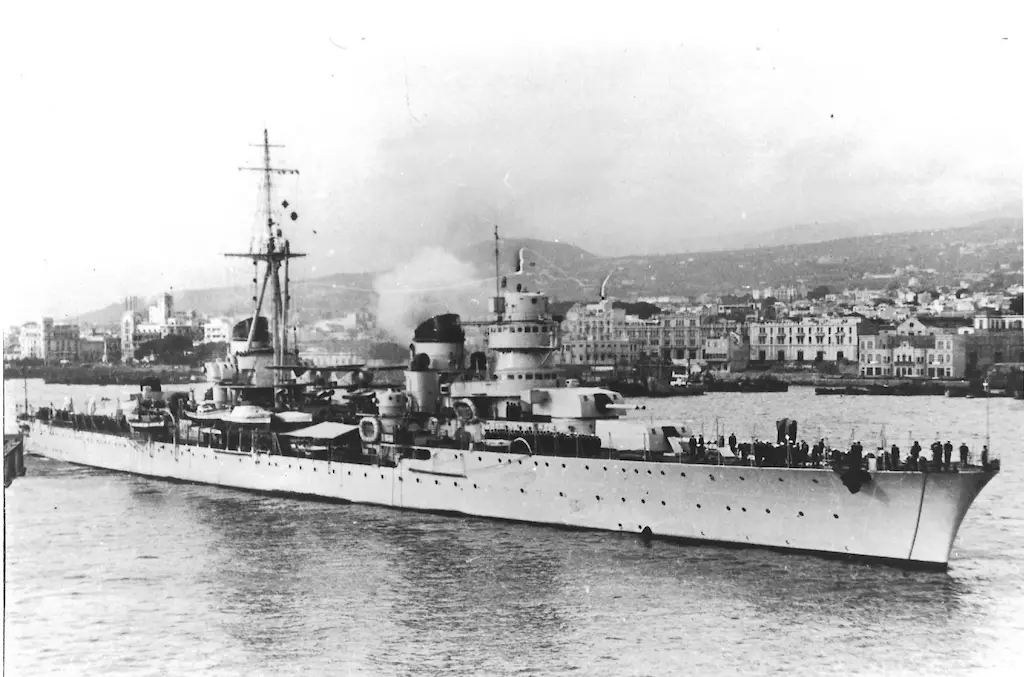Evolution of the Condottieri Class Light Cruisers
The Condottieri Class light cruisers are unique as a class within the Regia Marina. Strictly speaking, the class does not exist. The seemingly motley, disparate assortment of light cruisers counts members weighing between 6,000 and 10,000 tons! While a ship class is traditionally named for its first member, there was no Italian cruiser ‘Condottieri.’ Rather, they’re grouped by virtue of shared naming conventions. Each of the twelve ships of the class bears the name of a famous Condottieri, a military commander or statesman of Italian history.

Condottieri Class light cruisers consisted of five subclasses.
However, there is a deeper, logical connection to be made between the vessels. From one subclass to the next, a logical evolution of design is visible. They illustrate a shift away from fallacious ‘speed is armor’ ship designs, to formidable, balanced vessels. Interestingly, the shift is also demonstrated by the Trento heavy cruisers and the Zara class which followed them. However, the five iterations of Condottieri provide a more gradual, thorough look at this development.
While half of the Condottieri sank, a few, particularly the later designs survived the war. They enjoyed an active service record during the Second World War, fighting in numerous battles throughout the Mediterranean. After the war, Greece and the Soviet Union each received a Condottieri ship as reparations. The two Abruzzi class cruisers served with prestige in the post-war world. One played a role in the 1953 Trieste crisis, and the other became Europe’s first guided-missile cruiser.
Alberto di Guissano Class
The first and most numerous subclass of the Condottieri class began construction in 1928 and launched throughout 1930. Like so many Italian vessels, they were a response to new French construction. On paper, the La Fantasque ‘heavy destroyers’ overpowered any destroyers in the Regia Marina. In response, Italian planners envisioned superlight, 6,000-ton cruisers as an effective answer to the threat. Despite weighing approximately 6,000 tons, the vessels boasted impressive speed and armament. In trials, the Alberto di Guissano class cruisers achieved speeds of 42 knots, though practical speeds were around 37. Additionally, they bristled with an array of eight 152mm guns, arranged in four double turrets.

Alberto di Giussano class cruiser “Giovanni Delle Bande Nere” is a member of the Condottieri class cruiser line.
To achieve such good characteristics at a low weight, the design sidelined protection, seaworthiness and other qualities. While theoretically wonderful for combatting a few specific vessels in the French Navy, the early Condottieri class were fatally flawed otherwise. Ultimately, all four sunk by the end of 1942, and never fulfilled their raison d’etre of combatting French heavy destroyers.
Specifications
| Class | Alberto di Guissano Class |
|---|---|
| Type | Cruiser |
| Built | 1928-1930 |
| Displacement | 6,954 tons |
| Length | 555 ft (169.3 m) |
| Beam | 50 ft 11 in (15.5 m) |
| Propulsion | 2 shaft Belluzzo geared turbines 6 Yarrow boilers 95,000 hp (71,000 kW) |
| Speed | 37 knots |
| Range | 3800 nm (at 18 knots) |
| Crew | 507 |
| Armament | 8 × 152 mm guns 6 × 100 mm guns 4 × 533 mm torpedo tubes 8 × 37 mm guns 8 × 13.2 mm machine-guns |
| Armor | Decks: 20 mm (0.79 in) Belt: 24 mm (0.94 in) Turrets: 23 mm (0.91 in) Tower: 40 mm (1.6 in) |
– Class Members
Alberto da Guissano: The first ship of the class. An emergency mission to carry fuel to the Afrika Korps in December 1941 resulted in the Battle of Cape Bon. Despite her speed, an Allied destroyer task force intercepted and sank her on 13 December.
Alberico da Barbiano: Alberico da Barbiano accompanied Alberto da Guissano on the mission which resulted in the Battle of Cape Bon. Both ships sank in the course of the engagement on 13 December 1941.
Bartolomeo Colleoni: Briefly served in the Far East prior to the outbreak of World War Two. She initially served in mine-laying and convoy escort duties. The deficiency of her armor became clearly evident, as HMAS Sydney and accompanying destroyers sunk her on 17 July 1940.
Giovanni Delle Bande Nere: The longest-surviving of all the Guissano’s. Throughout 1940 and 1941, Giovanni fought in the convoy war around Malta, escorting troopships and laying minefields with reasonable success. She inflicted damage on HMAS Sydney at the Battle of Cape Spada, where Bartolomeo sunk on 17 July 1940.
At the Second Battle of Sirte on 22 March 1942, Giovanni successfully inflicted damage on the opposing cruiser Cleopatra. The next day, however, Giovanni Delle Bande Nere suffered damage in a storm and attempted to limp back to Naples. An ambush by the submarine HMS Urge split the ship in two, resulting in the death of over half the crew.
More info: Alberto da Guissano Class.
Luigi Cadorna Class
Launched in 1932, they were the most subtly iterative of the Condottieri classes. Their design sought to rectify the most glaring defects of the Guissanos. The ships enjoyed minor improvements to the gun layout and greater stability, thanks to ‘bulges’ installed in the armor. The basic design, dimensions, and purpose remained unchanged.
Specifications
| Class | Cadorna Class |
|---|---|
| Type | Cruiser |
| Built | 1930 |
| Displacement | 7,113 tons |
| Length | 555 ft (169.3 m) |
| Beam | 50 ft 11 in (15.5 m) |
| Propulsion | 2 Parsons geared turbines 6 Yarrow boilers 95,000 hp (71,000 kW) |
| Speed | 37 knots |
| Range | 3,088 nm (at 16 knots) |
| Crew | 507 |
| Armament | 8 × 152 mm guns 6 × 100 mm guns 4 × 533 mm torpedo tubes 2 × 37 mm guns 8 × 13.2 mm machine-guns |
| Armor | Decks: 20 mm (0.79 in) Belt: 24 mm (0.94 in) Turrets: 23 mm (0.91 in) |
– Class Members
Luigi Cadorna: The lead ship of the class. Her first action consisted of a role in the attack on Albania in 1939. Later on, she primarily performed second-line duties such as minelaying or transporting troops. Although, she also fought in the Battle of Calabria. One of the few Condottieri to remain after the war, Luigi Cadorna served as a training ship until retirement in May 1951.
Armando Diaz: Besides playing a part at the Battle of Punta Stilo, Armando Diaz had a fairly uneventful career. In February 1942, the ship sank with near-total crew losses after being torpedoed by HMS Upright.
Raimondo Montecuccoli Class
Launched in 1934, Raimondo Montecuccoli and her sister marked the first major change in the design of the Condottieri classes. It was here that the class shifted away from the destroyer hunter role in favor of proper cruiser design. In an attempt to increase protection and create a more balanced class of cruisers, designers added 2,000 tons. Of this, 765 t directly improved armor protection – more than doubling the original strength! The antiair armament grew dramatically, as four double mounts of 37mm cannons replaced the two 40mm cannons of the Cadorna class. The boilers were also strengthened, with an increase of hp above 10%, maintaining a top speed of 37 knots.

Raimondo Montecuccoli light cruiser.
However, the design remained under armored, particularly with regards to exceedingly weak deck armor. American Liberator bombers struck both ships in port, removing them from action indefinitely.
Specifications
| Class | Raimondo Montecuccoli Class |
|---|---|
| Type | Cruiser |
| Built | 1931 |
| Displacement | 8,994 tons |
| Length | 598 ft (182.2 m) |
| Beam | 54 ft 6 in (16.6 m) |
| Propulsion | 2 shaft Belluzzo geared turbines 6 Yarrow boilers 106,000 hp (79,044 kW) |
| Speed | 37 knots |
| Range | 4,122 nm (at 18 knots) |
| Crew | 578 |
| Armament | 8 × 152 mm guns 6 × 100 mm guns 4 × 533 mm torpedo tubes 8 × 37 mm guns 8 × 13.2 mm machine-guns |
| Armor | Decks: 20 mm (0.79 in) Main Belt: 60 mm (2.4 in) Turrets: 70 mm (2.8 in) Conning Tower: 100 mm (3.9 in) |
Class Members
Raimondo Montecuccoli: The first ‘proper cruiser’ of the Condottieri class, Raimondo Montecuccoli fought well and achieved several victories. The ship fought first at Punta Stilo and inflicted a sore defeat on the British at the Battle of Pantelleria. On 4 December 1942, American bombers struck Raimondo in port. They effectively took her out of action for the duration of the war. After the armistice, Raimondo entered internment in Malta but returned to Italy after the end of the war. She served in the role of a training ship until 1964, until her retirement.
Muzio Attendolo: Muzio Attendolo fought in major actions at the First Battle of Sirte, Punta Stilo, and Operation Harpoon. On 13 August 1942, the British submarine HMS Unbroken ambushed her. While undergoing repairs in Naples, she was struck by the same bombing raid that disabled Raimondo Montecuccoli. Muzio suffered the most severe damage, requiring repairs that must’ve made the scrapyard seem merciful.
Duca d’Aosta Class
The Regia Marina commissioned the two Duca d’Aosta Class cruisers between 1934 and 1935. This class marked a quixotic attempt to create a balanced design that maintained the incredible speed of previous Condottieri. Increases in armor offered some immunity to 152mm fire, and the powerplant increased to 110,000 horsepower. To accommodate the changes, the dimensions and tonnage grew substantially. While speed remained over-emphasized, the ships could still fight enemy cruisers on even terms. Additionally, the Duca d’Aosta Class has the distinction of serving in foreign navies.

A photo taken 18 November 1938 showing the Duca d’Aosta class cruiser Eugenio di Savoia.
Specifications
| Class | Duca d'Aosta Class |
|---|---|
| Type | Cruiser |
| Built | 1932-1933 |
| Displacement | 10,539 tons |
| Length | 613 ft (186.9 m) |
| Beam | 57 ft 5 in (17.5 m) |
| Propulsion | 2 shaft Belluzzo geared turbines 6 Yarrow boilers 110,000 hp (82,027 kW) |
| Speed | 36.5 knots |
| Range | 3,900 nm (at 14 knots) |
| Crew | 538 |
| Armament | 8 × 152 mm guns 6 × 100 mm guns 6 × 533 mm torpedo tubes 8 × 37 mm guns 12 × 13.2 mm machine-guns |
| Armor | Decks: 35 mm (1.38 in) Main Belt: 70 mm (2.8 in) Turrets: 90 mm (3.5 in) Conning Tower: 100 mm (3.9 in) |
Class Members
Emanuele Filiberto Duca d’Aosta: Commissioned in 1935, she launched a circumnavigation of the globe with her sister ship in 1938. However, she made it no further than South America before being recalled due to the global political situation. She fought in numerous engagements, beginning with the Battle of Punta Stilo and various convoy battles. As late as 1943, she attempted to bombard Allied positions around Palermo. Her career ended in Soviet service, renamed Kerch, in 1959. In her decades-long career, she never once suffered damage from enemy action.
Eugenio di Savoia: Eugenio di Savoia did not experience the most honorable trial by fire, as hardly anyone was shooting back. As a result of the pact between Franco and Mussolini, she bombarded Republican-held Barcelona in the Spanish Civil War. During the Second World War, her major engagements included Punta Stilo and Pantelleria, alongside Raimondo Montecuccoli in the latter case. The same bombing run which crippled the Montecuccoli-class cruisers also disabled Eugenio for the course of the war. After the war, she entered the Greek Navy. The Greeks renamed her Elli and employed the ship until they retired her in 1964.
Duca Degli Abruzzi Class
The culmination of the Condottieri classes, the Duca Degli Abruzzi represented the most formidable Italian light cruisers to see combat. Contrary to all prior subclasses, horsepower decreased in this iteration. With 100,000 horsepower and a service speed of 34 knots, the Duca Degli Abruzzi and her sister were still plenty powerful. But this small compromise and a modest increase in tonnage enabled significant improvements.

Giuseppe Garibaldi of the Duca Degli Abruzzi Class is the final design variation of Condottieri Class Light Cruisers.
Armor and torpedo survivability both improved, and the Abruzzi’s survived damage which sunk many of their predecessors. The most significant change received was their bolstered armament. They received two additional 152mm guns, mounted in a pair of new, triple turrets. The final pair of Condottieri cruisers, the Duca Degli Abruzzi Class could outrun and outgun most of their peers.
Specifications
| Class | Duca degli Abruzzi class |
|---|---|
| Type | Cruiser |
| Built | 1933 |
| Displacement | 11,735 tons |
| Length | 614 ft (187 m) |
| Beam | 62 ft (18.9 m) |
| Propulsion | 2 shaft Belluzzo geared turbines 6 Yarrow boilers 110,000 hp (82,027 kW) |
| Speed | 36.5 knots |
| Range | 3,900 nm (at 14 knots) |
| Crew | 640 |
| Armament | 10 × 152 mm guns 8 × 100 mm guns 6 × 533 mm torpedo tubes 2 x anti-submarines mortars 8 × 37 mm guns 12 × 20 mm machine-guns |
| Armor | Decks: 50-55 mm (2 in - 2.17 in) Main Belt: 100 mm (3.9 in) Turrets: 135 mm (5.31 in) Conning Tower: 30-140 mm (1.2 in-5.5 in) |
Class Members
Duca Degli Abruzzi: Her commission near the end of 1937 left her and her sister readily available for the war. At the opening of the Battle of Calabria, Abruzzi sallied forth and lead the Italian light cruisers in firing the first shots. She served in the convoy battles and fought at Cape Matapan, but escaped the disaster which ensued. After the armistice, she fought for the Allied-aligned government and patrolled the Atlantic in search of German raiders. In the postwar world, Duca Degli Abruzzi had her last ride in 1953. Serving as the flagship of the Italian mission to Trieste, Abruzzi played a part in returning Trieste to Italy. Eight years later, Marina Militare retired her.
Giuseppe Garibaldi: Garibaldi took place alongside her sister, Abruzzi, firing the opening salvos at the Battle of Calabria. After that, Garibaldi experienced the raid at Taranto and partook in several convoy operations. After the armistice, she joined Duca Degli Abruzzi, hunting German raiders in the Atlantic Ocean. Once the war ended, though, Giuseppe Garibaldi rose into prominence after 1961. In 1961, her refit to serve as Italy and Europe’s first guided-missile cruiser came to an end. Now an even more formidable force, she served as Italian flagship until 1972.
The Condottieri class well and truly came to an end in 1976, when the time came to break up Garibaldi for scrap.
